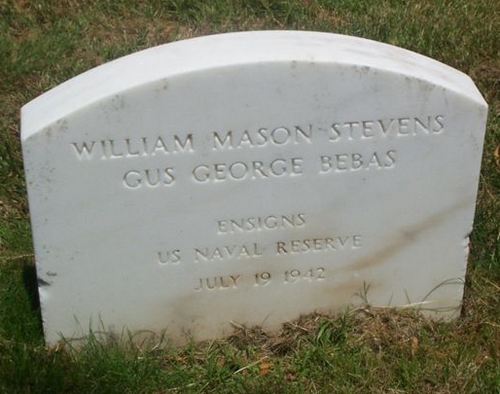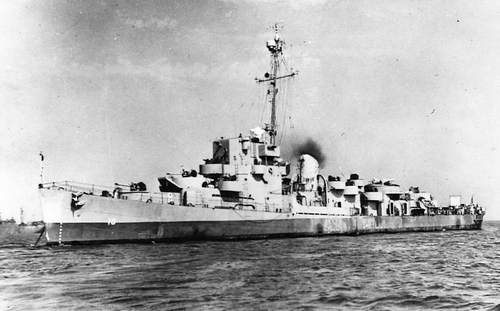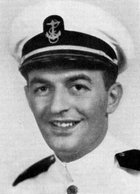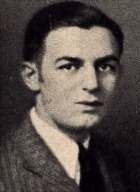Gus Bebas
| Date and Place of Birth: | February 24, 1914 Chicago, IL |
| Date and Place of Death: | July 19, 1942 Pacific Ocean, off Barber's Point, Hawaiian Islands |
| Baseball Experience: | Minor League |
| Position: | Pitcher |
| Rank: | Ensign |
| Military Unit: | Bombing Squadron 8 (VB-8) US Navy |
| Area Served: | Pacific Theater of Operations |
It is indeed a great honor to the Bebas family to contribute
in blood towards the noble cause of liberty. And though we all express a
deep sorrow on the loss of a brave young Greek-American, yet the honor
bestowed upon the Bebas family will be displayed in the annals of
history in honor of young Bebas who fought for the highest ideals of
humanity and civilization.
The Greek Star May 21, 1943
Constantine G. “Gus” Bebas was one of six children (four sisters and
a brother) growing up in a modest house on the east side of Wilmette, a
predominantly wealthy, lakefront suburb of Chicago. His parents, George
and Angeline - who operated a fruit and vegetable business - were Greek immigrants who were fiercely proud of their
country of birth and equally proud of their new home.
Bebas was educated at Wilmette
public schools and graduated from New Trier High School in nearby
Winnetka, where he was a star outfielder on the baseball team for three
years. He enrolled at Northwestern University School of Engineering at
Evanston, Illinois, in September 1934, and pitched for the varsity team
between 1936 and 1938. “Gus was always worried about the condition of
his right arm,” recalled George Lymper, captain of the 1938 team. “He
always massaged it the night before he was to pitch and slept with two
pillows under his arm.”[1] While at Northwestern, Bebas served in the
Naval Reserve Officer Training Corps as a platoon leader. He received
his commission as an ensign in May 1938.
Bebas graduated from Northwestern in June 1939, with a B.S. degree in
commerce. For two weeks, starting June 16, Ensign Bebas trained with the
Naval Reserve on board the newly built heavy cruiser USS Wichita at the
Philadelphia Navy Yard. Upon his return to Illinois he accepted an offer
from the Chicago White Sox to play minor league baseball.
He joined the Hickory Rebels of the newly formed Class D Tar Heel
League, but pitched just a handful of games before abandoning hopes of
an athletic career and took a job with the Hoover Company in Evansville.
During the winter, Bebas had given serious thought to becoming a navy
aviator and on January 22, 1940, he resigned his commission in the Naval
Reserve, enlisting as a seaman second class the following day. He took
flight training at the Naval Reserve Aviation Base at Glenview, a suburb
of Chicago, and was appointed an aviation cadet on February 19, 1941.
The following day, he reported for training at Naval Air Station
Pensacola, Florida, the hub of the Navy’s air training activities at the
time. The summer of 1941 also provided Bebas an opportunity to pitch for
the Pensacola Navy baseball team.
On August 4, 1941, Bebas was assigned to Naval Air Station Miami for
advanced carrier training and he was appointed a naval aviator on
September 5. On September 26, 1941, he was promoted to the rank of
ensign and returned home to Wilmette for a brief visit with family and
friends. When the Japanese attacked Pearl Harbor on December 7, 1941,
Ensign Bebas was serving with the Advanced Carrier Training Group,
Atlantic Fleet.
On December 23, he reported to Bombing Squadron 8 (VB-8) at Norfolk,
Virginia, part of the USS Hornet (CV-8) Air Group. At that time VB-8 was
equipped with the two-seat Curtiss SBC-3 Helldiver, a biplane dive-bomber
that had been in service with the Navy since 1938. On March 4, 1942, the
Hornet set sail from Norfolk for the West Coast via the Panama Canal
with VB-8’s new airplanes—Douglas SBD-3 Dauntless divebombers.
The Hornet arrived at Alameda, California, on March 20, and with her own
planes on the hangar deck, she loaded 16 Army Air Force North American
B-25 Mitchell bombers on the flight deck, under the command of
Lieutenant Colonel James “Jimmy” Doolittle. On April 2, the Hornet
departed Alameda and, for the first time, the crew was informed of the
Army flyers’ mission: a daring bombing raid on Japan. The Doolittle Raid
of April 18, 1942, was the first air raid by the United States to hit
mainland Japan. All 16 bombers were lost and 11 crewmen were either
killed or captured. But although the military significance of the raid
was minimal, it proved to be a substantial morale booster for the
American people.
With the B-25 bombers airborne and bound for Japan, the Hornet steamed
at full speed for Pearl Harbor, and remained there until April 30, when
she departed to assist the USS Yorktown and USS Lexington at the Battle
of the Coral Sea. The battle ended before the Hornet reached the scene
and she returned to Hawaii on May 26, and sailed two days later to stop
the anticipated Japanese assault on Midway Atoll. On the morning of June
4, 1942, Bebas engaged in his first combat mission as the Hornet
launched all available airplanes to search for Japanese aircraft
carriers. Loaded with a 1,000-pound bomb, Bebas and the other
dive-bomber pilots of VB-8 searched in vain for the enemy carriers. With
fuel running desperately low, not all made it back to the Hornet. One
plane ditched in the sea and Bebas was among many who had to land at
Midway Island. After refueling, he returned to the Hornet.
On June 5, 1942, Bebas was among 20 dive-bombers that were launched from
the Hornet to attack a small Japanese force of cruisers and destroyers.
Because they would operate at the limit of their combat range the
dive-bombers carried the smaller 500-pound bombs. When the fast-moving
Japanese destroyer Tanikaze was spotted, Bebas put his plane into a
vertical dive, selected his point of aim, and raced for his release
point amidst flak bursts from the destroyer’s anti-aircraft guns.
Frighteningly close to the huge destroyer, Bebas pressed the electrical
bomb release button, pulled out of his dive and closed the dive brakes.
Bebas’s bomb fell just 100 feet from the Tanikaze’s port quarter.[2] The
following afternoon, he participated in a strike against the heavy
cruisers Mikuma and Mogami, scoring a damaging near miss on the latter
ship. Following the Battle of Midway, the Hornet returned to Pearl
Harbor, where VB-8 became shore-based and returned to operational
training.
While on a routine training flight leading three planes on a dive
bombing practice off Oahu on the morning of July 19, 1942, Bebas put his
Dauntless into a dive to attack a target boat maneuvering off Barber’s
Point. He released his practice bomb at 2,000 feeten but instead of
immediately recovering and gaining altitude he entered a steep right
turn. Whether he blacked out or was unable to overcome the heavy stick
force present in the dive is unknown, but his plane crashed into the
ocean, killing himself and the observer/rear gunner, Ensign William M.
Stevens.
In April 1943, Bebas was posthumously awarded the Distinguished Flying
Cross for his involvement in the Battle of Midway. The citation
accompanying the medal, which was received by his mother, read in part:
“With utter disregard for his own personal safety, Ensign Bebas
participated in persistent bombing and strafing in the face of
tremendous anti-aircraft fire. His courageous conduct and stern devotion
to the fulfillment of a vastly important mission contributed materially
to the victory achieved by our forces.”[3]
The following month, his mother and sister, Anne, traveled to Boston,
Massachusetts, at the invitation of the Navy, to christen a destroyer
escort vessel named in Gus Bebas’s honor. The 1,400-ton USS Bebas
(DE-10) was
based in the Pacific until the cease of hostilities, performing patrol
and escort duties and receiving three battle stars.
“He was a student of whom we all felt proud,” eulogized Dr. Franklin B.
Snyder, president of Northwestern University, at a memorial service in
honor of Bebas at St. Andrew's Greek Orthodox Church in Chicago on June
27, 1943. “He was loved and admired by the students and his friends, one
we knew would have a distinguished record. We regret his death but we
take a pride in his heroism and his accomplishments. On behalf of the
university, I salute him!”[4]
Gus Bebas and Ensign William Stevens are buried at the Golden Gate
National Cemetery in San Bruno, California.
|
Year |
Team |
League |
Class |
G |
IP |
ER |
BB |
SO |
W |
L |
ERA |
|
1939 |
Hickory |
Tar Heel |
D |
- |
- |
- |
- |
- |
- |
- |
- |

A Douglas SBD-3 Dauntless dive bomber on the deck of the USS Hornet.


USS Bebas (DE-10)
Notes
1. Walter Merryman Paulison, The Tale of the Wildcats: A Centennial
History of the Northwestern University Athletics (Evanston, Ill.:
Northwestern University Alumni Association, 1951).
2. Through expert evasive maneuvering the Tanikaze avoided being sunk
despite being heavily damaged. She was eventually sunk on June 9, 1944.
3. Wildcat News, April 1943
4. Greek Star, July 2, 1943
Thanks to Kevin B. Leonard, University Archives at the Northwestern University Library for help with much of the material used in this biography. Thanks also to Astrid van Erp for help with photos for this biography.
Date Added January 23, 2012 Updated August 1, 2017
Baseball's Greatest Sacrifice is associated with Baseball Almanac
Baseball's Greatest Sacrifice is proud to be sponsored by



